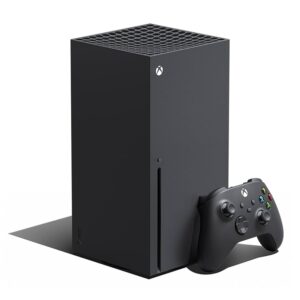
The Xbox Series X and Xbox Series S are Microsoft’s ninth-generation video game consoles, released in November 2020. They were designed to offer different entry points to the next generation of gaming, with the Series X being the more powerful console and the Series S being a more affordable, all-digital alternative.
Both consoles introduced several features to improve the gaming experience, including faster load times, seamless game switching, and a continued emphasis on the Xbox Game Pass subscription service.
The
Xbox Series X is the most powerful and expensive console of the two. It is designed for gamers who want the best possible performance, especially for use with a 4K television.
- Performance: Features a custom AMD Zen 2 CPU and an RDNA 2 GPU that delivers 12 teraflops of graphical power. Its performance target is native 4K resolution at 60 frames per second (FPS), with support for up to 120 FPS and 8K resolution.
- Storage: A 1TB Custom NVMe SSD significantly improves load times. Storage is expandable via proprietary expansion cards or slower external USB hard drives.
- Disc drive: Includes a 4K Ultra HD Blu-ray drive, allowing for physical game discs and movie playback.
- Design: It has a larger, monolithic tower design intended for vertical placement but can also be used horizontally.
The
Xbox Series S is the more compact and budget-friendly console, making it a good choice for those who want next-gen performance without needing native 4K graphics or a disc drive.
- Performance: Features a less powerful CPU and a 4 teraflop RDNA 2 GPU. It is designed to target 1440p resolution at 60 FPS, with support for up to 120 FPS. Games are upscaled to 4K when connected to a 4K display.
- Storage: The most common versions feature a 512GB or 1TB Custom NVMe SSD. Storage can also be expanded with proprietary expansion cards.
- Disc drive: The Series S is all-digital and does not include a disc drive.
- Design: It is the smallest Xbox ever, with a minimalist design and a large black vent on top.
Shared features and ecosystem
Despite their differences, the Series X and Series S share a number of key features that define Microsoft’s current-gen strategy.
- Xbox Velocity Architecture: This system-level technology, which includes the custom NVMe SSD and integrated software, drastically reduces load times and enables a fast user experience.
- Quick Resume: Allows users to suspend multiple games at once and resume them almost instantly, picking up exactly where they left off.
- Xbox Game Pass: Both consoles provide full access to Microsoft’s subscription service, which offers a large, rotating library of games, including new first-party releases on day one.
- Smart Delivery: This technology ensures that players automatically receive the best available version of a game for their specific console, regardless of whether they purchase a digital or physical copy.
- Backward Compatibility: Both consoles are compatible with thousands of games from previous Xbox generations (Original Xbox, Xbox 360, and Xbox One), with many titles seeing performance and visual enhancements.
- Next-Gen Tech: Both support advanced features like hardware-accelerated DirectX ray tracing and spatial sound technology like Dolby Atmos.